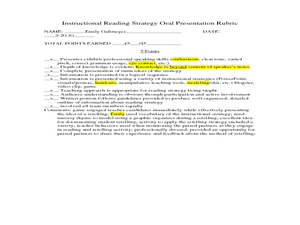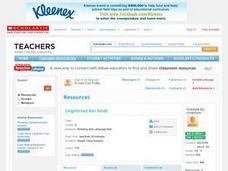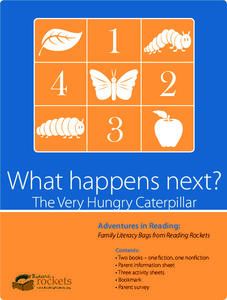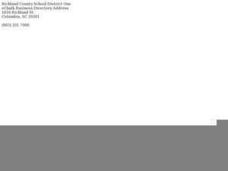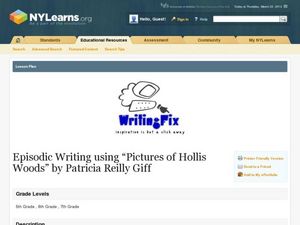Curated OER
Introduce: Summarizing Narrative Text
When scholars re-tell a story, do they boil it down to important details in a logical order? Practice summarizing narratives using this think-aloud strategy, which is scripted here for your convenience. After explaining why this is an...
Alabama Learning Exchange
Story Add-Ons
Fourth graders practice proper language conventions when word processing using portable keyboards. They use timed writing prompts and working in groups write a story that has a defined beginning, middle and end.
Curated OER
Writing: Mentor Text Lesson & Microteaching
Mentor texts are a great way to demonstrate how to write with purpose. Pupils will be reintroduced to two well-known books and then asked to think about them from the writer's point of view. They will see that the author had to use basic...
Curated OER
Retelling Stella Louella's Runaway Book: Point of View
Stella Louella’s Runaway Book launches a study of point of view and storytelling. After reading the tale, class members retell the story from the point of view of another character. The scripted plan, developed by a teacher candidate,...
Curated OER
Retelling
Explore language arts by completing a story worksheet in class. Readers will identify the importance of plot, setting, and character while they write their own short story. They also retell their story to a classmate and participate in a...
Curated OER
Gingerbread Man Retell
Explore the concept of retelling a story with the Gingerbread Man. Read various gingerbread man stories with your class. They will create character puppets and retell the story to one another and in small groups. Additionally, they will...
PBS
Reading Adventure Pack: What's Next? The Very Hungry Caterpillar
A series of hands-on activities follows a reading of The Very Hungry Caterpillar by Eric Carle. Learners create a paper collage to explore the beginning, middle, and end of days of the week, numbers, and more. They grow a butterfly...
Curated OER
What's the Real Story?
Second graders investigate tall tales. In this literature lesson, 2nd graders complete a story element worksheet based upon the tall tale of Paul Bunyan. Students create a PowerPoint presentation about a tall tale.
Curated OER
Chow
In this reading comprehension worksheet, young scholars read a four paragraph story. After reading, students answer five multiple choice, three short answer, and six fill in the blank questions about the story. They also write a...
Curated OER
Writing Parts of a Story
In this writing worksheet, students analyze the literary elements in a story. Students write short responses for the following categories: setting, characters, beginning, middle (problem), solution and end.
Curated OER
The Narrative Structure of Ethan Frome
This reading guide poses questions at the beginning, middle, and end of the reading of Ethan Frome. Readers focus on the setting, conflict, and resolution presented in the novel.
Curated OER
Sequencing The Three Billy Goats Gruff
First graders participate in sequencing activities. In this sequencing activity, 1st graders read the book the Three Billy Goats Gruff. Students retell the story and act out the scenes in groups. Students create a mural of the story...
Curated OER
School-Home Links: Writing Stories
In this writing worksheet, students learn to write stories with a clear beginning, middle, and end. Students write their story about a day at school. Students plan their stories by writing in the beginning, middle, and end charts and...
Curated OER
Humpty Dumpty: The Whole Story
Fifth graders analyze a nursery rhyme to explore the writing process. In this writing process lesson, 5th graders recite Humpty Dumpty and chart the plot of the story. Students select their own nursery rhyme and write a creative story...
Curated OER
Create An Ending
Students create a new ending for a familiar story that stand alone with a clear beginning, middle and end. As a class, students review a familiar text focusing on plot and character development. In small groups, students work...
Curated OER
Creative Writing
Students create a story with a beginning, middle and an ending. They also read and analyze another's story.
Florida Center for Reading Research
Comprehension: Narrative Text Structure, Story Pieces
An activity boosts reading comprehension by challenging scholars to answer questions about a narrative tale detailing elements—plot, characters, setting, theme, problem, and solution.
For the Teachers
Sequence Plot Chart
Your kids can identify the plot sequence of a short story, but what about an informational article? Have them examine the chronological order of events in informational texts with a lesson on the sequence of events.
Curated OER
Sequencing
Are you looking for a way to teach sequence of events in your narrative writing unit? Bring this lesson to your middle school class, as it prompts young writers to create a narrative sequence map of events that have happened at school...
Curated OER
Episodic Writing Using Pictures of Hollis Woods by Patricia Reilly Giff
Help your middle-schoolers expand their writing skills with this lesson plan on episodic writing, which focuses on story details, idea development, and organization. After reading "The Eighth Picture: End of Summer" from Patricia Reilly...
Curated OER
Folk Tales for ESL Students
Using the folk tale "The Man, The Boy, and The Donkey" (linked in the lesson) and a SMART board, teachers can help pupils access multiple skills. Reading the story allows learners to create a timeline of the sequence of events based on...
Curated OER
Story Elements Map
In this excellent story elements map worksheet, students view and discuss the advantages and disadvantages of using a graphic organizer to help structure stories and compositions. To my eye, this graphic organizer will help students...
Curated OER
Snow Globe Family
Kindergartners sequence the parts of a story using a snow globe as a setting. They will listen to Snow Globe Family and retell the parts of the story noting the beginning, the middle, and the end. Then they will make their own snow...
Curated OER
Beginning, Middle, End in Paragraph Writing
In this descriptive writing worksheet, students use the titles to each page to write a beginning, middle, and ending paragraph for each title. Students write 5 stories.




